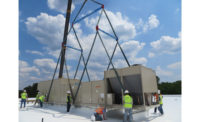A comfortable indoor climate begins with proper humidity and temperature control. In fact, the Environmental Protection Agency (EPA) notes that relative humidity that is too high can contribute to the growth and spread of unhealthy biological pollutants, which definitely have a negative effect on building occupants.
Rooftop unit manufacturers are responding to this need to control humidity by outfitting their units with a dehumidification component. How each unit removes moisture varies from manufacturer to manufacturer, but they have a universal goal: to improve the comfort of building occupants by controlling humidity.

Humidity Control Without Cooling
Lennox is one of the manufacturers now offering a dehumidification option. Its Humiditrol® system can be factory installed on the company’s high-efficiency L Series® rooftop units.Mike Walker, marketing specialist with Lennox Industries Inc., Richardson, Texas, says the company came out with the system in response to customers’ needs to improve the comfort level of their buildings by maintaining proper temperature and humidity.
The system’s main advantage “is the ability to provide humidity control independent of the need for cooling,” notes Walker. “The system can operate in several modes, including dehumidification and no cooling, dehumidification and partial cooling, or dehumidification and full cooling. This allows the system to remove a high amount of moisture while still maintaining a comfortable temperature, preventing problems such as overcooling the occupied space.”
Walker states that the Humiditrol system achieves this enhanced humidity control by initiating the dehumidification cycle based on a humidity setpoint, not a temperature setpoint like most conventional air conditioning systems. “That improves humidity control even on mild temperature load days, when many temperature-initiated systems cannot remove enough moisture from the air to maintain the recommended level of humidity,” he says.
The Humiditrol consists of three components: a reheat coil, three-way valve, and check valve. It is controlled by the Integrated Modular Controller (IMC), a rooftop unit controller that can control almost every function of this rooftop unit. The humidity control system starts operating when the IMC initiates the dehumidification cycle, which happens when it senses that room temperature is satisfactory but the humidity level is above the desired setpoint.
This action starts the operation of the fans and compressors, as well as the reheat and cooling coils. The mixed indoor/outdoor air is cooled and dehumidified as it passes through the evaporator coil. The cooled and dehumidified air is heated back to near room temperature as it passes through the hot gas reheat coil. The unit continues to operate in this mode until the dehumidification demand is satisfied.
“This system works particularly well on days that are, for example, 65 degrees F and humid. With the Humiditrol, it’s not necessary to rely on a call for cooling to dehumidify,” says Walker. “It will basically bring in dehumidified air without making the environment cold and clammy.”
The L Series rooftop units come configured to order from the factory. According to Walker, these units do not require contractors to perform additional work during installation. “We also have tool-less access doors for the compressor section and the reheat coil, so it’s quick and convenient for contractors to install and maintain.”

Coil Technology
Global Energy Group (GEG) also emphasizes dehumidification with its “Inventor Series 1400” packaged rooftop units. GEG decided to offer a low-cost dehumidification option during initial marketing/development stage of the Inventor Series 1400 packaged unit by combining system attributes with its patented “E-Coil” technology.The technology allows the heat transfer of the complete coil to be at its optimum level, states Todd VanHyfte, executive vice president, GEG, Odessa, Fla. “By using our cold-colder-coldest cooling methodology, we are able to accomplish dehumidification in four stages by simply varying the cfm of the supply fan. What makes this different than all the other competitors is that our patented E-Coil evaporator coil will not freeze up, which causes compressor failures.”
GEG says that its evaporator temperatures operate at 7 degrees to 10 degrees higher than standard or high-efficiency conventional systems, while providing better dehumidification even at high-speed fan conditions. This results in evaporator temperatures that are above freezing even at low air volumes.
“By operating at a higher evaporator temperature, the E-Coil technology allows us to provide a very effective dehumidification scheme without using a reheat option,” notes VanHyfte. “This avoids the significant reduction in EER when using the reheat approach. Instead, GEG’s dehumidification options maintains our Inventor Series’ exceptional EER rating.”
The end user will also see the following benefits, according to VanHyfte:
Adding to the last point, VanHyfte says that if this rooftop unit is already purchased and used, a field-install kit can be added to cost-effectively incorporate all four stages of dehumidification. If factory installed, the added two-speed fan motor and control board option can cost up to $500 more than the Inventor Series 1400 unit price. However, VanHyfte says the operating costs for dehumidification are lowered when compared to traditional cooling-only units, due to the fact that the humidity control scheme uses higher-than-rated full- and part-load EER conditions, with little or no reheat costs.
Other rooftop unit manufacturers are also introducing a dehumidification component to their equipment, mainly due to the demand by end users. Basically, end users are looking for cost-effective ways to implement dehumidification in their buildings. Manufacturers such as Lennox and GEG are filling the need by offering consumers various dehumidification options.
Publication date: 06/23/2003





